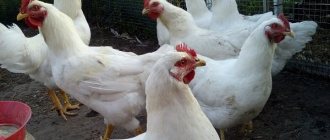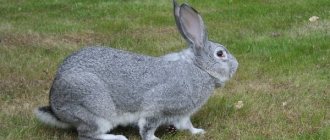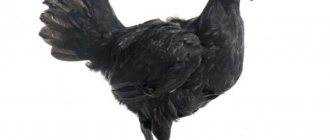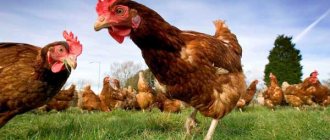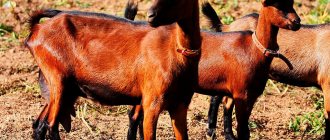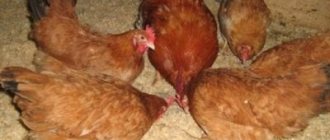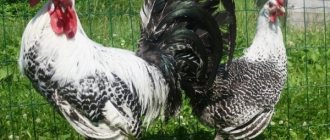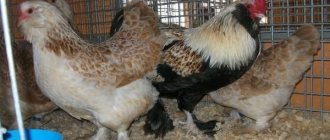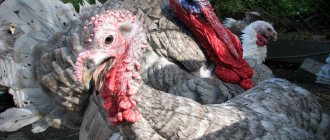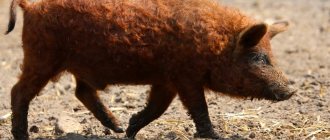Chickens of the Indonesian breed Ayam Tsemani are distinguished from other relatives by their extremely unusual appearance. Plumage, entrails, skin, bones, muscle tissue - everything in the body of this bird is jet black. The validity of this information is proven by the fact that on the scale of shades the color of this decorative individual is equal to 10 points out of 10 possible.
Ayam Tsemani is a decorative breed of chickens with black meat.
Historical information about the breed
This unusual, blue-black chicken is the oldest domesticated bird. Scientists believe that people were breeding it several thousand years ago. The homeland of black chickens is the Indonesian islands, even a specific island is called Middle Java. It is believed that Ayam Tsemani first appeared on the outskirts of the town of Solo.
It is assumed that Ayam Tsemani appeared as a result of crossing jungle fowls - domestic or bank fowls, with roosters of green jungle fowls. There is also a possibility that there is no pure Ayam Tsemani breed; all its representatives are half-breeds.
The Tsemani owe their total blackness to a genetic mutation, due to which they became victims of fibromelanosis. The dominant gene responsible for the production of the melanin enzyme is 10 times more active in black chickens.
Temperament
Potential owners of Ayam Tsemani should take into account that chickens have a specific character. They do not get along well with other birds. Roosters can cause serious injury to domestic animals and humans. Laying hens are a little calmer. However, they are easily frightened. The sharp sound causes the chickens to jump or scatter in different directions. Due to panic, they are capable of bumping into a hard object and injuring themselves.
Birds cannot sit in one place for a long time. They love to explore the territory. In the absence of a good fence, chickens can easily fly to another area. Representatives of the breed are not very good hens. Laying hens are able to leave the nest before the chicks hatch.
Exterior of a bird
Today there is no single standard description of the breed in its original form. Information about origin and appearance is passed on by the people of Indonesia from generation to generation. The main difference between the breed and what makes it unique is its absolutely black color. Moreover, these chickens have black not only plumage, but also all other parts of the body - eyes, skin, legs, beak, comb, earrings.
Individuals that have at least a little light color are not allowed to reproduce - so as not to spoil the “blackness” of the breed.
Main features of the exterior:
- the head is small;
- the body is compact, trapezoidal in shape;
- eyes small, black;
- comb – straight, leaf-shaped, toothed;
- the beak is shortened, black, with a thickening at the end;
- earrings round or oval;
- face and lobes are black;
- neck of medium length;
- chest – slightly protruded;
- the legs are long, with four splayed toes;
- the wings fit tightly to the body, slightly raised;
- The tail of roosters has very elongated braids; the tail of chickens is more modest, but also quite luxurious.
In Java, when reading “ayam cemani”, the sound “s” is heard as “ch”, so there is a double spelling of the second component of the breed’s name – “tsemani” or “cemani”.
Mystical chickens Ayam Tsemani - who are they?
We are already accustomed to the fact that chickens can come in a variety of colors, but there is a breed that still never ceases to amaze even experienced poultry farmers. Ayam Tsemani are completely black chickens that do not have a single light spot.
Breed overview
It’s hard to believe, but the Ayam Tsemani ornamental chickens are truly completely coal-black birds. Not only their plumage, but even their skin is dark in shades. Needless to say about tongue, organs, bones and meat! The bone marrow of this unusual breed is also black; even their blood is so dark that it could easily pass for black.
Origin
These amazing birds, which amaze the imagination even in the photo, came from Indonesia. Translated into Russian, the name sounds like “Tsemani chicken”. Cemani is a village located near the city of Solo in Middle Java.
In 1920, colonialists from Holland became acquainted with the unique bird, and in Europe they first learned about these exotic chickens in 1998. Jan Stevernik began studying this breed and the characteristics of its origin. Research led to the fact that in the same year it was possible to breed the first hen of this breed, and the next year - a rooster.
The breed immediately provoked an unprecedented stir, since the appearance of the bird was fascinating and evoked mystical associations. Today, Ayam Tsemani chickens are considered one of the most expensive breeds in the world. The cost of one chicken reaches 2.5 thousand dollars.
Many breeders believe that now there are no purebred Ayam Tsemani left, since the original individuals have long since died out. There is an opinion that poultry farmers are currently breeding a hybrid of a unique breed, which is valued in the same way as Ayam Kedu.
Appearance
The first thing worth mentioning in the description of the unusual Ayam Tsemani is the incomparable coloring. You're probably wondering how it happened that even chickens have combs darker than night. The fact is that birds owe this coloration to a genetic feature - fibromelanosis.
This gene provokes the rapid development of a large number of black pigment cells. Scientists have proven that this mutation originated more than eighth centuries ago in Asia. As mentioned above, modern representatives of the described breed are black in color. Moreover, if a light color appears anywhere on an individual, then this is considered a defect, and such a hen or rooster is not used for breeding.
As for the body, it is not too large and has the shape of a trapezoid. The neck of Ayam Tsemani chickens is of medium length, and the head is small in size. The chest of individuals can hardly be called very full, however, it is quite rounded. The wings fit quite tightly to the body.
Cockerels can be recognized by their large, regularly shaped comb and fluffy, high tail. Both laying hens and males have earrings that are round and completely black. The breed is characterized by the presence of a short black beak with a thickening at the end. Ayam Tsemani's eyes are also completely black. This can be seen in the photo.
Productivity
On average, a chicken of the Ayam Tsemani breed reaches 1.2 kilograms, and roosters rarely gain more than 1.8 kilograms. The egg production of laying hens is quite satisfactory - in the first productive period, the hen produces about a hundred dark-colored eggs. The weight of one testicle is about 50 grams. Individuals of this breed have a good survival rate - 95%.
Interesting Facts
In Asia, Ayam Tsemani are valued very highly - this is due to the tendency of the local population to endow surrounding objects and animals with mystical characteristics. Sometimes these black chickens are sacrificed to increase the birth rate of the people. In addition, Ayam Tsemani is considered a symbol of good luck. There is a widespread belief among Asians that eating black chicken can ease pangs of conscience. If a rooster of this breed crows, then prosperity awaits the owners of the bird.
Finding poultry breeders in Russia who would keep Ayam Tsemani is very difficult, since even private breeders cannot guarantee that the breed is pure. Judging by the reviews of the lucky ones, black chickens fly well. So good that some even have to put a roof on their yard to avoid losing the birds.
Many note that individuals of this breed are distrustful and reluctant to come into contact with people. They prefer to stay apart, however, chickens cannot do without the care of their owners. The fact is that they have never seen snow, and therefore in winter it is necessary to provide the birds with good heating. The surface of the barn should be covered with a mixture of hay and peat about 5 centimeters thick. This is the only way to prevent birds from freezing.
Video “Rare breed rooster Ayam Tsemani”
In this video you can see how the male Ayam Tsemani behaves at home and hear about the peculiarities of his keeping.
Popular myths about the breed
Black chickens Ayam Tsemani are very rare. It is very difficult to find them in Russia, and they are incredibly expensive. It's no surprise that this strange breed is shrouded in myth. In Indonesia, Ayam Cemani is endowed with mystical properties. They are sacrificed here to increase the birth rate. Among the local population, these birds are also considered a symbol of good luck.
Ayam Tsemani is not all black, as many “experts” claim. Firstly, their blood is red - due to hemoglobin. Secondly - eggs. There are many photos of Ayam Tsemani’s black eggs on the Internet – this is a hoax. In fact, these chickens have light-colored eggs, both outside and inside.
Black chicken carcasses are rare, but if you come across them on the shelves, they are probably Chinese silk chickens. They, unlike the Indonesian Tsemani, have only black skin, and the meat, bones and internal organs are ordinary.
Disease Prevention
If the birds are kept in a properly equipped chicken coop, and their diet includes all the necessary nutrients, the flock will not get sick often. This is due to the fact that the wild ancestors of the Ayam Tsemani were distinguished by amazing vitality and passed this feature on to their domesticated relatives.
However, the high immunity of the breed does not mean that vaccinations can be neglected, especially if there are other birds on the farm. Timely vaccination will help protect the flock from parasites and infections, and the only possible problem will be a cold, but this can be easily avoided by properly arranging the chicken coop.
An overview of the representatives of this unusual breed is given in the video.
Spreading
Europeans first became acquainted with black chickens in the 20s of the 20th century - at that time immigrants from Holland began to study them. And black chickens came to Europe only in 1998, they were brought here by a Dutch breeder.
The breed is rare; today it can be found among farmers in Holland, Slovakia, Germany, the Czech Republic, Belarus, Ukraine, the USA, Great Britain and very little in Russia.
Diet
The bird's diet should be composed of succulent and green feed - approximately 70%. Chickens do not eat much, but are selective in their food. They prefer green grass, although they do not refuse vegetables, fruits, and root vegetables.
For normal development, chickens must be provided with constant access to clean water and concentrated feed. For this purpose, different grain mixtures and feed are used. Chickens should be fed a balanced diet. If you switch them entirely to grain or mixed feed, the unique properties of eggs and meat are lost.
Productivity and egg production
A good laying hen lays about 200-250 eggs per year, chickens from Indonesia - no more than a hundred. Black hens lay cream or light brown eggs. The taste of black chicken eggs is the same as that of ordinary laying hens. The yolk and white are traditional colors. But the meat of Indonesian chickens is black, but it is tasty and tender, it has little fat, and it is considered dietary. This breed even has black bones and internal organs.
To obtain maximum egg production, it is recommended to add a vitamin and mineral supplement to the feed of laying hens, for example, “Ryabushka”.
Productivity indicators of Ayam Tsemani:
| Index | Meaning |
| Egg production, eggs per year | 100 |
| Weight of one egg, g | 45-50 |
| Chicken weight, kg | 1,5- 2 |
| Rooster weight, kg | 2-2,5 |
Egg production reaches its peak in the first year of laying eggs, then the number of eggs laid decreases. The taste of meat deteriorates by the 4th year of a bird’s life.
Survival rate of young animals is 95%. Considering the high cost of the breed, this indicator is especially important for breeders.
Eggs of black chickens
Sometimes the color of eggshells has unusual shades - blue, green, emerald colors are formed due to biliverdin (a derivative of bile). The brown tint is formed under the influence of the pigment protoporphyrin, which covers the outside of the shell with a thin layer when it comes into contact with the walls of the oviduct. This pigment is present in laying hens with variegated and charcoal colors.
What color eggs a black or mottled chicken has depends on its breed, age, time spent in the sun and other factors. Eggs with dark brown shells are laid by marans.
The black color of eggs is actually absent from the natural palette.
Advantages and disadvantages
Usually, chickens are valued for their economic benefits - meat and egg productivity, and the ability to hatch eggs. In Ayam Tsemani they value the bird itself, its appearance and the purity of the breed. Appearance is the main advantage of this breed.
There are no analogues to Indonesian chicken in the world. This explains the incredible cost of black chickens - only wealthy poultry farmers and collectors of rare breeds can buy such birds.
In addition to her unique appearance, Ayam Tsemani has other advantages:
- delicacy meat, tasty, tender and also black;
- hens take good care of the chicks;
- good immunity.
Flaws:
- low egg production;
- chickens have a poorly developed brooding instinct;
- distrust and lack of contact;
- do not tolerate cold well;
- special conditions - a warm chicken coop and a paddock, fenced on all sides.
Which is better?
Types of black chickens are conventionally divided into 3 main categories depending on their purposes:
- decorative;
- egg;
- egg and meat.
Therefore, it is best to choose a breed after you decide which variety suits you. It must be taken into account that in any of the categories egg production is quite active in all breeds
Therefore, it is important to consider whether you need decoration, and whether the birds will be slaughtered for meat. Based on this, select the variety
Rate the chickens based on three indicators: body weight, number of eggs per year, egg weight. Meat breeds are larger and heavier; if you rely on egg production, take the number of eggs and their weight as a basis.
It is important to know that the productivity of chickens can be increased, but this must be done as carefully and carefully as possible. Under no circumstances should chemicals be used
Content recommendations
Ayam Tsemani comes from warm places, so the main problem when breeding them is cold winters. To keep birds healthy and productive, they need a warm and comfortable coop, as well as a proper diet.
Conditions of detention
Ayam Tsemani chickens are a capricious breed. They are very thermophilic and demanding of their maintenance:
- Temperature conditions. Tsemani do not tolerate sub-zero temperatures well, so the main condition for keeping them is maintaining warmth in the chicken coop. When cold weather sets in, chickens are not allowed outside. The room temperature should not fall below +15 °C.
- Air mode. Chickens need fresh air, so the room should be well ventilated, but without drafts.
- Psychological climate. Black chickens are shy; there should be no sharp extraneous noise near their home. You should also approach them with extreme caution so as not to scare them. Chickens can injure themselves while trying to escape.
- Lighting. For 20 sq. m. area, a 40 W lamp is sufficient. Or an energy-saving lamp equivalent to the specified power. Bright light is not needed - it promotes bird aggression. To extend the egg production period, the chicken coop is illuminated for 12-14 hours in winter.
- Neighborhood. Ayam Tsemani should not come into contact with birds of other species - they are unfriendly and a conflict may arise, which will end fatally for expensive birds.
Young and adult birds of Ayam Tsemani are kept separately. To prevent adult birds from fighting, use glasses or a beak ring. The glasses do not allow the chickens to “aim” for a strike, and the ring does not allow the beak to close for a full strike. But these devices have drawbacks - chickens can throw off their glasses, and the ring injures the beak.
What should a chicken coop be like?
Any room, barn or poultry house can be used as a chicken coop. If there is no suitable room, they build an ordinary barn of stone or timber. The walls are ordinary, height – 2.5 m.
Choose a sunny place - Tsemani love warmth. In the southern regions, the chicken coop is placed so that in the summer it is shaded. The roof is constructed so that there is no threat of collapse under the weight of snow. For southern regions, it is important that the roof protects the birds from the heat. Polycarbonate can be used as a roofing material.
Chicken coop requirements:
- A separate section is equipped for each chicken family. The poultry house is divided into sections using a regular chain-link mesh so that air circulates well in the room.
- They build a barn in a dry place, not flooded by flood and groundwater. Otherwise, the building is placed on a foundation, having previously drained the soil.
- The chicken coop must be insulated. The floor and walls are insulated with mineral wool or polystyrene foam. The cracks are sealed, a layer of heat-insulating material is placed on the floor - at least 15 cm. You can use straw or peat. In winter, the chicken coop is heated - electric heaters are installed or heating is provided in advance.
- Perches are arranged in the chicken coop at a distance of 1.5-2 m from the floor.
- In chicken coops built in the southern regions, the doors are made double - one is solid, the other is mesh. It is completely closed in winter, and the mesh door improves ventilation in summer.
- Room for 1 family includes one rooster and 19 hens.
- The windows of the chicken coop should face south to increase daylight hours, the doors should face east or west to prevent north winds from blowing into them.
- In the northern regions, chicken coops are equipped with forced ventilation in order to turn it off during severe cold weather.
- For nesting, boxes measuring 30x50x20 cm are built. The bottom of the box is lined with hay or straw. Sawdust is not suitable - it will “spread” to the sides, and the eggs can be damaged on bare boards.
- Perches are made from round timber d=5 cm. The wood must be dried and without cracks - otherwise it will harbor parasites. The best material for a perch is oak or aspen.
- Feeders are made of a bunker or trough type - so that the chickens do not scatter the food. Feed holes are made so that the bird cannot get its feet into the feed. You can learn how to make a feeder yourself from this article.
- Drinkers are made using nipple type; in such closed containers the water is always clean and fresh. If you want to make drinking bowls with your own hands, then read this article.
A pen will be set up next to the chicken coop. Tsemani fly well, so the height of the fence is at least 2 m. It is not necessary to sow grass, the chickens will quickly eliminate it anyway. It is better to sprinkle the ground with fine gravel and give the greens along with the food.
The aviary is equipped with drinking bowls, feeders, baths with sand and ash, and a canopy is also installed so that the birds can shelter from bad weather.
Is it possible to build it yourself?
Black chickens spend most of their time in the chicken coop, so it should be comfortable, both for the birds’ lives and for maintenance. Build it at the rate of 2 individuals per 1 sq. m.
How to build a chicken coop:
- Foundation. For a small shed, a foundation is not necessary - it is enough to dig metal stands around the perimeter to protect it from digging. For a large herd, a permanent building is built. The best foundation option is columnar.
- Floor. It is better to make double floors - to make it warmer. A subfloor is laid on the foundation. There is sawdust between the sheathing elements. Insulation, for example, mineral wool, is placed on top of the subfloor. The main floor is then nailed in place. The boards are taken even so that there are no cracks or holes through which cold air will penetrate.
- Walls. Height – 1.8-2.5 m. The best option is wooden beams. They are knocked down with nails or screws. The beams are covered with boards on both sides. Thermal insulation material is laid between the boards and beams. The walls are painted to protect them from insects and weather conditions.
- Roof. You can make a roof with two slopes and an attic space. You can store equipment and feed in the attic. First, a flooring is made, on which a heat insulator is placed - for example, expanded clay or slag. Then they put roofing felt, and slate or other roofing material is placed on it.
- Aviary. Its area should be twice the area of the chicken coop. The floor of the enclosure is earthen so that the chickens can look for insects.
- Setting up a chicken coop. For each bird - 30 cm of perch. Perches cannot be placed on top of each other. To make cleaning easier, trays are placed under the perches.
What and how to feed Ayam Tsemani?
Black Indonesian chickens do not require special nutrition, they eat any food and do not suffer without their specific food. Features of feeding Ayam Tsemani:
- The basis of the feed can be grain, or industrial compound feed, which includes wheat, corn and other grains. Correctly selected feed is the key to high egg production.
- To obtain tasty and juicy meat, poultry is fed meat waste and insects.
- They provide wet mash flavored with vitamin and mineral supplements. Shells and crushed eggshells are used as the latter - they are also necessary to prevent blockage of the goiter. Mixtures can be made using meat and fish broths.
- Fish oil is added to the feed. It has a positive effect on the beauty of plumage and overall health.
- In the cold season, when greens are in short supply, chickens are given grass meal, hay, silage, pulp and vegetables are added to warm mash. Chickens are also fed sprouted grain. Yeast and bran are added to the mash.
Feeding
The only difficulty in breeding Australorps is feeding - due to their rapid growth, Australorp chickens require balanced, nutritious food. Otherwise, chickens may start laying eggs without shells.
- Stern
- Recipes
- Supplements
Compound feed pk-1
Description of food for egg breeds. Instructions for feeding laying hens
Read
Compound feed pk-2 and pk-3
Mineral and vitamin compositions, feeding standards
Read
Compound feed pk-4
Used to feed laying hens aged 15-17 weeks
Read
Compound feed pk-5
Composition and instructions for feeding broiler chickens
Read
Purina Pro
Important differences from the previous line, application patterns Start, Growth, Finish
Read
Barley and wheat for laying hens
Germination and steaming of barley and wheat for chickens: how to do it correctly and how to give it to laying hens
Read
Wheat for broilers
Rules for feeding broiler chickens with wheat. Dosage for chickens from the second day of life and adult birds
Read
Mash
Making mash for broilers at home
Read
Rice and buckwheat
How and in what form you can use rice and buckwheat to feed chickens. Standards for adult birds and chickens
Read
Bread
What kind of bread can you feed chickens and how to do it correctly
Read
Fish
The product is given in limited quantities: overfeeding can cause serious harm to the bird Contents
Read
Chalk
Chalk as a food additive for chicken feed. Feeding standards for chickens, young animals and laying hens
Read
Meat and bone meal
Meat and bone meal is a mandatory additive for feeding chickens, containing protein and fats of animal origin.
Read
Fish fat
How to give fish oil to chickens, layers and broilers. What are the benefits of the drug and are there any contraindications?
Read
Limestone
Limestone (dolomite) flour in the diet of chickens. Advantage over chalk and feed shell
Read
Salt
Daily dosage of salt for adult birds and young animals and cases of unwanted use
Read
Breeding "Indonesian"
To obtain “purebred” Ayam Tsemani, the family is kept separately from other breeds. The “wild” gene in the pedigree of the “Indonesians” had a beneficial effect on the fertility of the birds.
Subtleties of mating
Chickens and roosters are taken from unrelated families. It is better that the birds come from different farms. If two roosters are purchased, the manufacturer is changed for the next year. The ideal sex ratio is 5 hens per rooster.
The high fertilization ability of nigellas was inherited from the wild green junglefowl. Fertilization of eggs among “Indonesian” women is almost 100%.
Incubation period
Females have a brooding instinct, but it is not their obligatory quality. To hatch or hatch, you have to use an incubator. It is not known whether the chicken will hatch the eggs to the end; if she refuses to hatch, the clutch will have to be urgently saved, so it is better to prepare an incubator in advance.
Incubation lasts 21 days. Temperature – +37.8°C. If you increase it, the chickens will hatch prematurely - this should not be allowed. If the incubator does not have automatic egg turning, you have to turn them manually every 2 hours - a very tedious and responsible task. Turning stops only two days before the chicks hatch. The temperature is then reduced to +37.5°C.
We recommend reading the article about the features of incubating chicken eggs at home.
Care of offspring
Newborn chicks are black, squeaky, with short fluff. From birth they have strong immunity. Survival rate is 95-100%. To ensure that the chicks do not get sick and grow well, it is important to provide them with favorable conditions:
- For the first two weeks, the temperature is maintained at +28-+30 °C. Then the temperature is gradually reduced to room temperature.
- When the chickens grow up, they are transferred to a separate windproof enclosure. You cannot keep young birds together with adult birds; among them there may be aggressive individuals that will kill the young offspring. Young birds are placed with adult birds at two months of age.
Nutrition from early days to adulthood
Feeding Features:
- The chickens are given starter feed - regular millet with eggs is not enough for them. Chopped eggs are added to the feed. Dry food is left freely available.
- In the first week, chickens are fed cottage cheese with a fat content of up to 15%. They also give crushed corn grits and greens.
- Vitamins are given to each chicken - dripping into its beak.
- From one month, chickens are completely transferred to balanced feed - they are selected according to age. Feed is taken with a high protein content. The diet should also include herbal flour, root vegetables, and mineral supplements. Maggots are recommended.
- Boiled water is given in special drinking bowls. In addition to water, the chicks are given a glucose solution and weakly brewed tea.
Planned herd replacement
Black chickens are often purchased for decorative purposes; in this case, there is no need to rush to replace the stock - the birds can live safely and decorate the poultry yard for a long time.
In theory, the breeding stock is replaced annually. Birds are selected for breeding and a new flock is formed. Birds that are not suitable for breeding are sold or slaughtered. It is not possible to carry out a planned replacement with the Ayam Tsemani breed due to the rarity of the breed. And then the degeneration of the breed becomes inevitable.
In order to delay degeneration as much as possible, old laying hens are left behind, and the strictest selection is carried out among the young. If you try very hard, you can avoid inbreeding (family ties) - but then out of 10 chickens you will have to select no more than one pullet.
Incubation
Ayam Tsemani are good hens, however, they can sometimes leave the nest. For breeding it is better to use an incubator. Survival rates under natural and artificial brooding conditions are no different.
Table of temperature and humidity modes
| Period |

